Global Discoveries on DVD: Fantasies and Favourites

By Jonathan Rosenbaum
Circa 1978, while I was living in a San Diego suburb and teaching a film course, I wrote a letter to Dr. Seuss (Ted Geisel), who lived in another San Diego suburb, inviting him to come to my class and talk about The 5,000 Fingers of Dr. T (1953), which he co-wrote and helped to design—an eccentric and lavish fantasy musical that has been one of my favourite ’50s movies ever since I saw it at age ten on Times Square during its initial release, but a colossal commercial flop that was notoriously difficult to research. By way of answering my letter, Geisel phoned me one afternoon and cordially explained to me why he didn’t want to come to my class. This movie takes the form of a ten-year-old boy’s nightmare, and for Geisel, the whole experience of working on it remained a total nightmare for him for several reasons, which he described to me at some length.
The project grew out of his friendship with screenwriter Carl Foreman in the US Army Signal Corps during World War II, and their shared friendship or acquaintance with Stanley Kramer; the trio planned to make a movie together when the war was over, with Foreman directing. But a series of disasters struck, one after the other: Foreman was blacklisted, Kramer made substantial changes to Geisel’s conception (the most important of which involved substituting a slick radio star, Peter Lind Hayes, for an elderly Polish plumber to be played by Karl Malden, and, to a lesser extent, casting Hayes’ wife Mary Healy as the little boy’s mother), and various other conflicts and tensions led to the film’s director, Roy Rowland, having a nervous breakdown in mid-production, so that Kramer himself had to step in and take over. Geisel also described what happened during the shooting of the climactic sequence in which the hundreds of little boys enlisted to perform on a single piano keyboard got sick on hot dogs and, through a grotesque chain reaction, all started to throw up at once.
Geisel might have cited other nightmarish experiences he’d had on the picture, but these are the ones I remember. When I asked him if he minded if I wrote about what he’d told me, he said no, as long as I didn’t quote him—and since I didn’t record our conversation, this wasn’t an option anyway. The article that emerged wound up in the October 1978 issue of American Film and is also available on my website, and I presume that the people at powerhousefilms.co.uk who contacted me about their “limited dual-format edition” and quoted me briefly in their booklet discovered this piece too late for them or Glenn Kenny and Nick Pinkerton (who do the joint audio commentary) to make more than cursory use of its information. For regrettably, it seems that Geisel gave no interviews at all about the film, or at least none that are readily accessible today. According to Wikipedia, “Geisel regarded the film as a ‘debaculous fiasco’ and omitted mention of it in his official biography.”
My main difference with Kenny and Pinkerton—apart from the fact that I love the film and they seem to regard it as a sometimes interesting but basically inexplicable curiosity—is essentially generational. They mainly relate it to subsequent decades (and as an occasion for gossip about the subsequent lives, careers or opinions of Tommy Rettig, Hans Conreid, and Hayes), whereas I relate it almost exclusively to the ’40s and ’50s and to the conceptions of Dr. Seuss (even though, admittedly, they probably know more about the Seuss books than I do). And even though they’re alert to Geisel’s hatred for dictators, they’re far less alert to the degree that the entire film is an allegory for the experience of WWII shared by Geisel, Foreman, and Kramer—up to and including its atomic-bomb conclusion, capped by Hayes and Healy driving off in what looks like an Army jeep, and including barbed wire and searchlights, concentration-camp horrors, music as a form of aggression and even torture (in both the dungeon and at the endless piano keyboard), goose-stepping grandiosity and grandiloquent garb, surveillance, and mind control. It’s even possible to conclude that Bart’s dead father perished in that war, and the plumber alludes at one point to his own stint in the army, while one can easily assume that the piano teacher, an obvious sissy, must have been 4F. To quote Wikipedia again, “In the wake of the success of [the Oscar-winning cartoon] Gerald McBoing-Boing, Geisel submitted a live-action storyline for The 5,000 Fingers of Dr. T in 1951. Geisel followed it up with a 1,200-page script, with ‘themes of world dominance and oppression coming out of World War II.’ Geisel relocated from La Jolla, California, to Los Angeles during filming to ‘enable him to be more involved in the production.’ His influence on set design and choreography is also evident in the film.” His influence on the song lyrics and costume design seems no less evident: for the latter, I’m thinking especially of Mary Healy’s split-personality dress design in the climactic sequence, reflecting her conflicted relationship to both Terwilliker and Zabladowski.
Pinkerton and Kenny seem to keep forgetting that nearly all of the film’s action is a ten-year-old boy’s dream, so that when one of them criticizes the “inanity” of the varied contents of Bart’s pockets creating an “atomic” concoction, he seems to be wanting even more of the ruinous Hollywood conventions that Kramer imposed on the film and less of the unusual dream logic that the movie excels in. (According to the more “up-to-date” De Palma logic of what a dream is supposed to be like, which I find inane, it’s merely an occasion for a storytelling twist, not a poetic concoction with its own peculiar sense of reality.) But I don’t mean to suggest that Kenny and Pinkerton are any less historical than some of my near-contemporaries. “When I was born,” writes Kurt Andersen in his fascinating but sometimes maddening 2017 book Fantasyland: How America Went Haywire, a 500-Year History, “restaurants were neither national businesses nor themed. That changed as suburbs fulfilled the old-timey small-town American dream and as Disney cracked the code for themed commerce.” But according to Wikipedia, Andersen was born in 1954, and Howard Johnson’s storybook-expressionist-themed-restaurant business, already well established by then (and founded in 1925), “was the largest restaurant chain in the US throughout the 1960s and 1970s.” Which prompts the realization that The 5,000 Fingers of Dr. T is ultimately a direct descendent of The Cabinet of Dr. Caligari (1920), the first famous German Expressionist film, with its own anti-authoritarian slants (in both senses of that term) and crazy sets.
The juxtaposition of two masculine role models, Dr. T and Mr. Z, is also a contrast in terms of class, culture, and separate ethnicities (German versus Polish). If Karl Malden had been cast as the plumber and had also played a character roughly twice as old as Hayes, as Dr. Seuss intended, the Oedipal stakes would have been quite different. But as it stands now, the film is commonly described as “flawed”—apparently in order to excuse the general public for rejecting it—even though it strikes me even today as far less flawed than many so-called classics that made lots of money, ranging from The Birth of a Nation (1915) to an atrocity like, say, Midnight Express (1978). For me, the Frederick Hollander score, the lyrics, the sets, the choreography (especially in the remarkable dungeon ballet), the uses of Technicolor (supervised by Francis Cugat, brother of Xavier, who designed the original book jacket for The Great Gatsby, as the audio commentary usefully informs me), the performance of Hans Conried, and the screenplay (even after Kramer’s meddling) suffice to make it a classic. Someone who seems to agree with me is Michael Feinstein, who contributes to a couple of other extras, and who put together an excellent CD box set devoted to the score (including many recovered songs and interludes that were cut from the film). And for all my caveats—including my regrets that Pinkerton and Kenny don’t show as much relaxed expertise and historical perspective as Tony Rayns on the recent Arrow dual-format box sets devoted to Seijun Suzuki’s Taisho Trilogy (1980-1991) and Rainer Werner Fassbinder’s Eight Hours Don’t Make a Day (1972-73), two imposing landmarks I’m just beginning to explore (see below)—this Powerhouse release is superior in every respect to the Olive Films Blu-ray that preceded it.
***
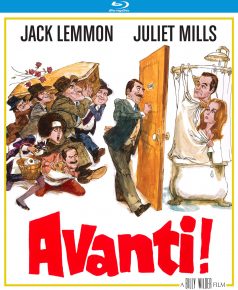 There are also now two Blu-ray editions of Billy Wilder’s Avanti! (1972), for me the most perfectly scripted item in the Wilder canon and one of the most perfectly realized. What makes the Kino Lorber version superior in some ways to the French edition that I covered in Cinema Scope 62 (which also includes the equally underrated Kiss Me, Stupid [1964]) are informative interviews with Juliet Mills and Clive Revill, the first of whom can be said to appreciate Avanti! and Wilder far more intelligently than most reviewers, who continue to be stuck in the arid stretches of such fare as The Apartment (1960) and The Fortune Cookie (1966), with their soppy-sentimental endings. (She even cites her admiration for some of Wilder’s pre-Hollywood European work.)
There are also now two Blu-ray editions of Billy Wilder’s Avanti! (1972), for me the most perfectly scripted item in the Wilder canon and one of the most perfectly realized. What makes the Kino Lorber version superior in some ways to the French edition that I covered in Cinema Scope 62 (which also includes the equally underrated Kiss Me, Stupid [1964]) are informative interviews with Juliet Mills and Clive Revill, the first of whom can be said to appreciate Avanti! and Wilder far more intelligently than most reviewers, who continue to be stuck in the arid stretches of such fare as The Apartment (1960) and The Fortune Cookie (1966), with their soppy-sentimental endings. (She even cites her admiration for some of Wilder’s pre-Hollywood European work.)
***
 I don’t have Dominik Moll’s very rewatchable French psychological thriller Lemming (2005) on Blu-ray, and don’t even know if it can be found in that format with English subtitles, but my Artificial Eye DVD from the UK, still available at bargain prices (and with extras, which the US DVD seems to lack), does just fine. This is a film that confounds our usual sense of what’s subjective and objective, real and unreal, much better than most, starting with its airborne miniature camera in the opening sequence, and winds up disappointing me only when it half-heartedly tries to rationalize most of its fantasies in objective terms at the end. (Admittedly, The 5,000 Fingers of Dr. T. does that as well, but with a much clearer generic purpose.)
I don’t have Dominik Moll’s very rewatchable French psychological thriller Lemming (2005) on Blu-ray, and don’t even know if it can be found in that format with English subtitles, but my Artificial Eye DVD from the UK, still available at bargain prices (and with extras, which the US DVD seems to lack), does just fine. This is a film that confounds our usual sense of what’s subjective and objective, real and unreal, much better than most, starting with its airborne miniature camera in the opening sequence, and winds up disappointing me only when it half-heartedly tries to rationalize most of its fantasies in objective terms at the end. (Admittedly, The 5,000 Fingers of Dr. T. does that as well, but with a much clearer generic purpose.)
***
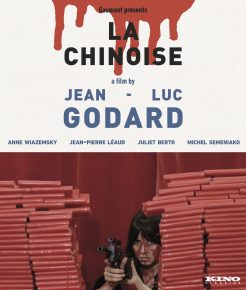 Two superb Blu-ray editions from Kino Lorber of two Jean-Luc Godard features, one of them a major effort in spite of its periodic foolishness (La Chinoise, 1967), the other a crashing and crushing bore in spite of its dubious prestige (Le Gai Savoir, 1969). The periodic foolishness of La Chinoise resides in its naive politics, expertly unpacked by one of its own actors, Michel Semeniako, in a very intelligent interview—the first of five expertly conducted and filmed by Pierre-Henri Gibert. And what makes the film a major effort is its brilliant arsenal of organizing aesthetic strategies, which are completely at odds with its foolish and irresponsible political strategies. This isn’t to suggest that such a mismatch didn’t have many bizarre consequences: speaking as someone who once took a bus from New York to Philadelphia to catch an early preview of the film, and later had some friends at Columbia University who saw the film many times during its brief New York run in early April 1968, very shortly before taking over the buildings on their own campus (an act which likely added some fuel to the May events in France the following month), I suspect that the brilliance of the aesthetics could very easily get entangled with the stupidity of the politics by college students eager for change, myself included.
Two superb Blu-ray editions from Kino Lorber of two Jean-Luc Godard features, one of them a major effort in spite of its periodic foolishness (La Chinoise, 1967), the other a crashing and crushing bore in spite of its dubious prestige (Le Gai Savoir, 1969). The periodic foolishness of La Chinoise resides in its naive politics, expertly unpacked by one of its own actors, Michel Semeniako, in a very intelligent interview—the first of five expertly conducted and filmed by Pierre-Henri Gibert. And what makes the film a major effort is its brilliant arsenal of organizing aesthetic strategies, which are completely at odds with its foolish and irresponsible political strategies. This isn’t to suggest that such a mismatch didn’t have many bizarre consequences: speaking as someone who once took a bus from New York to Philadelphia to catch an early preview of the film, and later had some friends at Columbia University who saw the film many times during its brief New York run in early April 1968, very shortly before taking over the buildings on their own campus (an act which likely added some fuel to the May events in France the following month), I suspect that the brilliance of the aesthetics could very easily get entangled with the stupidity of the politics by college students eager for change, myself included.
In his excellent audio commentary, James Quandt alludes to the Columbia uprising’s relation to La Chinoise as mythical, but on the basis of my own visit to the Columbia campus during the student takeover, I would call this a myth with a real-life basis. Regarding Adrian Martin’s own capable audio commentary to Le Gai Savoir, I can only add that Godard being fully plugged into the intellectual debates of the period didn’t yield any brilliant aesthetic strategies of his own this time, only a series of dull echoes of those debates, in college-outline form, without any real characters or sustained wit (despite the use of two of the previous film’s actors, Juliet Berto and Jean-Pierre Léaud).
 Yet another recent Kino Lorber Blu-ray, Daniel Raim’s documentary Harold and Lillian: A Hollywood Love Story (2015), is neither a fantasia nor a favourite, strictly speaking, but this delightful portrait of a storyboard artist-turned-art director and a research librarian, who both individually and collectively form a significant chapter in the unrecorded history of Hollywood, can only be warmly recommended.
Yet another recent Kino Lorber Blu-ray, Daniel Raim’s documentary Harold and Lillian: A Hollywood Love Story (2015), is neither a fantasia nor a favourite, strictly speaking, but this delightful portrait of a storyboard artist-turned-art director and a research librarian, who both individually and collectively form a significant chapter in the unrecorded history of Hollywood, can only be warmly recommended.
***
There appears to be a certain conspiracy of silence about the previous digital releases of Orson Welles’ Othello (or what was described and labelled as that film when it was released in 1992) in relation to the recent, infinitely superior Criterion release of the same film: Criterion makes no mention of this 1992 version, and neither does J. Hoberman in the New York Times (among many other reviewers). Admittedly, the inclusion on Criterion’s Blu-ray of two separate Welles edits and sound mixes (1952 and 1955) and the very first digital release of Welles’ 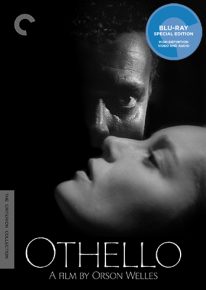 Filming Othello (1979) clearly supersedes all the more questionable releases of a tampered-with version of one of those Othello edits a quarter of a century ago. But since a good many copies and multiple editions of that screwed-up version (authorized, alas, by Welles’ daughter Beatrice) are still kicking around the planet and won’t be disappearing anytime soon, there’s good reason to acknowledge and take the trouble to avoid this previous version—which eliminated the original Francesco Lavignino score for the sake of a postmodernist stereo pastiche of it (without bothering to consult the manuscript of the original score held by Lavignino’s heirs), and made many other questionable changes in order to improve the lip-sync (which is discussed in some detail by Michael Anderegg in his excellent book Orson Welles, Shakespeare, and Popular Culture). This conspiracy of silence, while it understandably glides past the ill-informed and now embarrassing endorsement of that version by Hoberman, Vincent Canby, and many others at the time, shouldn’t be sustained by everyone today. Indeed, the Criterion Blu-ray is impeccable, apart from one minor blooper of its own: Simon Callow, momentarily confusing Filming Othello with the similarly designed but never-completed Filming “The Trial,” calls the earlier film unfinished—an error contradicted on this release’s own flap copy (“Welles’ last completed film”).
Filming Othello (1979) clearly supersedes all the more questionable releases of a tampered-with version of one of those Othello edits a quarter of a century ago. But since a good many copies and multiple editions of that screwed-up version (authorized, alas, by Welles’ daughter Beatrice) are still kicking around the planet and won’t be disappearing anytime soon, there’s good reason to acknowledge and take the trouble to avoid this previous version—which eliminated the original Francesco Lavignino score for the sake of a postmodernist stereo pastiche of it (without bothering to consult the manuscript of the original score held by Lavignino’s heirs), and made many other questionable changes in order to improve the lip-sync (which is discussed in some detail by Michael Anderegg in his excellent book Orson Welles, Shakespeare, and Popular Culture). This conspiracy of silence, while it understandably glides past the ill-informed and now embarrassing endorsement of that version by Hoberman, Vincent Canby, and many others at the time, shouldn’t be sustained by everyone today. Indeed, the Criterion Blu-ray is impeccable, apart from one minor blooper of its own: Simon Callow, momentarily confusing Filming Othello with the similarly designed but never-completed Filming “The Trial,” calls the earlier film unfinished—an error contradicted on this release’s own flap copy (“Welles’ last completed film”).
***
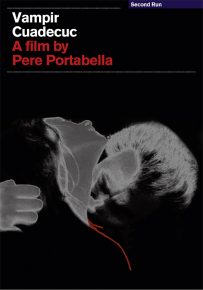 Since I’m mentioned several times on Second Run Features’ Blu-ray of Pere Portabella’s Cuadecuc-Vampir (1970), another longtime favourite, I hope I can be excused for calling this another exemplary edition of an essential work. Part of what makes it so welcome to me, apart from a new and lengthy interview with Portabella about the making of his masterpiece, are a couple of recent Portabella shorts, La Tempesta (2003) and No al No (2006), comprising further collaborations of Portabella with composer Carles Santos. Back in the early ’70s—when I was still living in Paris, and shortly after I discovered Portabella’s Vampir and Umbracle (1970) in successive years at Cannes and wrote about both films in the Village Voice—Santos looked me up in Paris and we spent a couple of pleasant afternoons together without speaking a word of each other’s language, with the French painter Dorothée Selz serving as our mutual interpreter.
Since I’m mentioned several times on Second Run Features’ Blu-ray of Pere Portabella’s Cuadecuc-Vampir (1970), another longtime favourite, I hope I can be excused for calling this another exemplary edition of an essential work. Part of what makes it so welcome to me, apart from a new and lengthy interview with Portabella about the making of his masterpiece, are a couple of recent Portabella shorts, La Tempesta (2003) and No al No (2006), comprising further collaborations of Portabella with composer Carles Santos. Back in the early ’70s—when I was still living in Paris, and shortly after I discovered Portabella’s Vampir and Umbracle (1970) in successive years at Cannes and wrote about both films in the Village Voice—Santos looked me up in Paris and we spent a couple of pleasant afternoons together without speaking a word of each other’s language, with the French painter Dorothée Selz serving as our mutual interpreter.
***
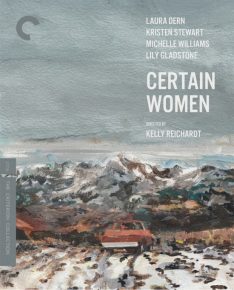 It must seem improper for me to classify my favourite Kelly Reichardt film—Certain Women (2016), now out on a Blu-ray from Criterion—as a fantasy, even after readily acknowledging that all films are fantasies. But the interviews on this edition with Reichardt, executive producer Todd Haynes, and author Maile Meloy (who wrote the three stories on which the film is based), which all hover over the artistry and diverse ramifications of Reichardt’s careful adaptation of these three stories, finally goaded me into ordering Meloy’s Half in Love, which includes the first two. Many of the characters in this book seem like stepchildren of the lonely “grotesques” in Sherwood Anderson’s Winesburg, Ohio. And the second sentence of the first story in Meloy’s collection, “Tome,” expertly adapted as the first story in Certain Women, reads, “Sawyer had worked construction for thirty years, building houses for people with Montana fantasies.”
It must seem improper for me to classify my favourite Kelly Reichardt film—Certain Women (2016), now out on a Blu-ray from Criterion—as a fantasy, even after readily acknowledging that all films are fantasies. But the interviews on this edition with Reichardt, executive producer Todd Haynes, and author Maile Meloy (who wrote the three stories on which the film is based), which all hover over the artistry and diverse ramifications of Reichardt’s careful adaptation of these three stories, finally goaded me into ordering Meloy’s Half in Love, which includes the first two. Many of the characters in this book seem like stepchildren of the lonely “grotesques” in Sherwood Anderson’s Winesburg, Ohio. And the second sentence of the first story in Meloy’s collection, “Tome,” expertly adapted as the first story in Certain Women, reads, “Sawyer had worked construction for thirty years, building houses for people with Montana fantasies.”
***
Neither The Taisho Trilogy nor Eight Hours Don’t Make a Day qualify (yet) as favourites of mine, and only the first of these is an obvious fantasy, but Arrow Academy’s initiative in restoring and making each of these available in well-appointed, dual-format packages deserves to be celebrated. Suzuki’s trilogy is highly regarded in Japan, but is only now making its Western debut. So far, I’ve only watched Zigeunerweisen (1980), the first feature, and for all its ghosts and doppelgängers, and its startling and beautiful way of handling certain flashbacks without cuts, I find it less ravishingly sensual than Suzuki’s Pistol Opera (2001), even though it may be just as eccentric and enigmatic in terms of its minimal plot and archetypal characters.
***
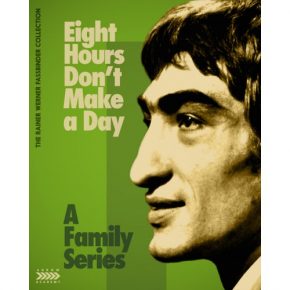 In the case of Fassbinder’s working-class comedy-drama Eight Hours Don’t Make a Day, a five-part, 478-minute TV miniseries that until now has been almost equally scarce, I’ve so far watched the first two feature-length episodes; my interest started to flag in the third, though I’m planning to make a return visit soon. Centred on a single family and its lovers, friends, and factory co-workers, this appears to be, as Rayns suggests, the warmest and sunniest work in the Fassbinder canon, with an especially strong set of women characters. (Fassbinder makes wonderful use of Luise Ullrich, one of the lead actresses in Max Ophüls’ Liebelei [1933], and even briefly shows her watching that film with a few others on German TV.) It was scripted and conceived in eight parts, but WDR discontinued its funding after five episodes without saying why (although Fassbinder suspected this was because of political developments in the unfilmed chapters). The fact that it features so many members of Fassbinder’s famous repertory company—including Hanna Schygulla, Gottfried John, Kurt Raab, Irm Hermann, Margit Carstensen, Ulli Lommel, Eva Mattes, and Brigitte Mira—adds to its interest and appeal; Schygulla and John make a particularly lovable romantic couple.
In the case of Fassbinder’s working-class comedy-drama Eight Hours Don’t Make a Day, a five-part, 478-minute TV miniseries that until now has been almost equally scarce, I’ve so far watched the first two feature-length episodes; my interest started to flag in the third, though I’m planning to make a return visit soon. Centred on a single family and its lovers, friends, and factory co-workers, this appears to be, as Rayns suggests, the warmest and sunniest work in the Fassbinder canon, with an especially strong set of women characters. (Fassbinder makes wonderful use of Luise Ullrich, one of the lead actresses in Max Ophüls’ Liebelei [1933], and even briefly shows her watching that film with a few others on German TV.) It was scripted and conceived in eight parts, but WDR discontinued its funding after five episodes without saying why (although Fassbinder suspected this was because of political developments in the unfilmed chapters). The fact that it features so many members of Fassbinder’s famous repertory company—including Hanna Schygulla, Gottfried John, Kurt Raab, Irm Hermann, Margit Carstensen, Ulli Lommel, Eva Mattes, and Brigitte Mira—adds to its interest and appeal; Schygulla and John make a particularly lovable romantic couple.


